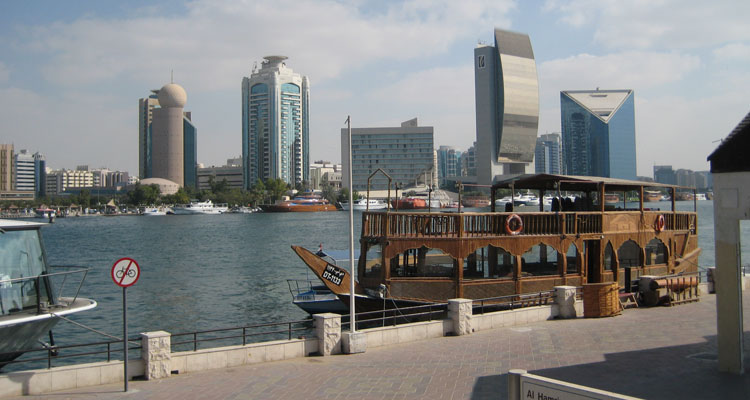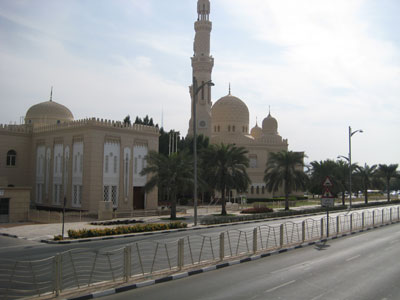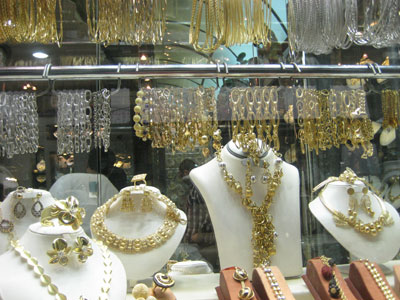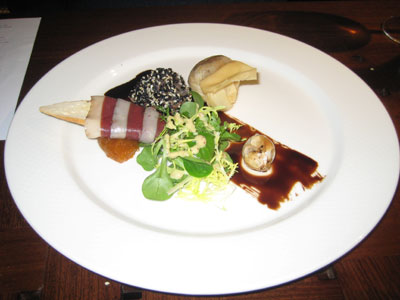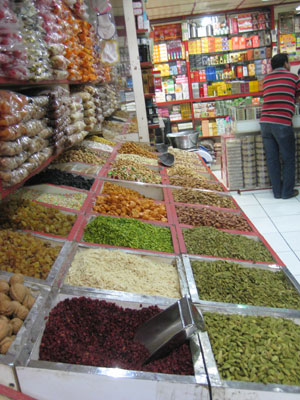Three days in dazzling Dubai
by Fred Steinberg, New York, NY
When it comes to Dubai, there are two kinds of international travelers: those who put it on their “Top Ten Places to Visit” list and those who can’t understand why it’s on those lists at all. Considering this, my wife and I were the perfect couple to visit this Arab colossus in the desert.
Often referred to by critics as “Disney World Middle East,” the emirate has been near the top of my list for 20 years, ever since I spent two hours in the airport there during a layover and was dazzled by the shops (including one featuring a Rolls-Royce — duty free, of course). My wife, however, was very much one of the ‘Why?’ travelers.
First impressions
Arriving early on a January 2011 morning, our first view of Dubai was mirage-like — giant skyscrapers piercing through the morning haze. Passing through the sprawling, sparkling airport, we were a touch mesmerized by the lilting morning call to prayers echoing through the terminal. We stared at the giant duty-free shop where the Rolls-Royce was now replaced by a Maybach and a high-end BMW.
In many ways, Dubai International Airport serves as a metaphor for the entire city-state. Terminal Three, especially, impresses in every way. It is not only the world’s largest air terminal, it’s the world’s largest building (by floor space), encompassing 370 acres and containing more than 80 moving walkways, 97 escalators, 157 elevators and 2,600 parking spaces.
Welcome to Dubai, where everything seems over the top, from the world’s tallest building and one of the largest indoor ski areas to the biggest man-made island and the largest and most expensive all-suite hotel.
One of seven city-states of the United Arab Emirates, Dubai is the second largest, by area, with a population of nearly two million. The mixture of dress includes a small minority of women in black burkhas and men in the traditional national dress of white flowing robes and caps, but many residents are clothed in traditional Western garb, from business suits and dresses to jeans and short-sleeve shirts.
With the desert temperatures of 60 to 80 degrees in the winter, often climbing above 120 in the arid summer, you may occasionally see shorts and tank tops, but conservative dress is appropriate in this predominately Muslim nation.
This variety of dress reflects the fact that some 80% of Dubai’s residents are expats, including the businesspeople who came to ride the construction, finance and tourist boom and the thousands of Indians, Pakistanis, Filipinos and other Asians who fill the emirate’s administration and manual construction needs.
Exploring Dubai
We took an inexpensive cab ride ($35) to our four-star midtown hotel, the Crowne Plaza Dubai (Sheikh Zayed al Nahyan Road, Box 23215, Dubai, UAE; phone 877/2-CROWNE)*, but you can save with a 20-minute metro trip (about $7).
The Crowne Plaza, at $135 per night, bills itself as five stars, but my wife and I give it four. It's basically an "institutional"-style business/tourist hotel with an outstanding location and a good health club/spa and an outdoor heated pool. However, the food outlets are overpriced even by Dubai standards, with the breakfast buffet in the main dining room running $45.
In my opinion, the ambiance was uninspired, with service at the front and concierge desks uneven and never overly customer-friendly.
To see the city, we purchased a two-day Big Bus Tours (phone +971 [0] 4 340 7709) hop-on/hop-off pass. The Big Bus makes 20 stops in the older center city and newer northeast Gulf coast areas. It’s a great buy at AED285 ($77).
We focused our first day of touring on the areas surrounding the city center, taking the Big Bus Red Route to the Al Fahidi Fort (Bus Stop Six). The fort, built in 1787, now houses the Dubai Museum, where life-size dioramas, interactive exhibits, photos and videos trace the rise of Dubai from a series of small, sleepy Bedouin desert date farms, trading posts, and pearl diving and fishing settlements to the modern country it is today.
We exited the museum into the historic Bastakiya neighborhood, with its art galleries and landmark courtyard houses. We stopped at the Heritage Village, a re-creation of a typical Bedouin settlement, and the Al-Ahmadiya School Museum, a sample of classic Arabic architecture.
Dubai’s Grand Mosque, which can accommodate 1,200 worshipers, is closed to non-Muslims, but its most impressive exterior is well worth a look. The hub of the emirate’s religious activity, it surrounds Dubai’s tallest minaret and features 54 domes and a series of sky-blue mosaics imbedded in its sand-hued facade.
We next took the bus to Stop Eight for a visit to the Sheikh Saeed Al Maktoum House. Built in 1896, it features striking beamed ceilings and sculpted arches and illustrates the history and development of Dubai through a collection of early pottery, jewelry, photos, paintings and lithographs.
Bus Stop Nine, our next stop, was the “markets” area. We started with the Gold Souk, a glittering feast for the eyes, with every variety of bauble, bangle and bead you can imagine — from ingots to intricately worked jewelry — which glisten from some 100 shop windows lining a covered arcade.
We were getting hungry and could smell the chicken, beef and lamb kabobs from the adjacent food stall area. We washed one down with a yogurt drink followed by delicious hot, spiced tea, which helped warm the touch of winter chill.
Just outside of the food area, we could smell the shops of the Spice Souk, filled with a wide variety of colorful spices, chilies, nuts, incense, figs, dates and other dried fruits overflowing from huge sacks. Saffron is a particular bargain, as it’s cheaper here than most anywhere else.
Tea shops feature up to 50 varieties, including jasmine pearl, osmanthus, Ti Kwan Yin and Long Jing. Since haggling is the rule of the day, we practiced our limited skills a bit.
We also perused the many shops featuring belly-dancing costumes, enjoying the view, but we were not in the market for dancing slippers.
An evening out
Our first evening stop was the Burj Al Arab, the world’s tallest all-suite — and, arguably, most luxurious — hotel. Shaped like a giant sail set over the Gulf, it has become a Dubai landmark. It is so iconic that its distinctive shape appears on Emirates license plates.
Rack rates start at $1,450 for a one-bedroom suite, though occasional seasonal promotions can be found for under $500.
We made a sundown reservation in advance for the Skyview Bar (e- mail baarestaurants@jumeirah.com), 650 feet above sea level, which provides a magnificent view of Dubai. Sundown comes early in the winter, so we made sure to be there by 5:30.
We ordered the bar package, which included two drinks and canapés ($52) and watched the sun set and the city lights twinkle on. It was a show we will not soon forget.
Given that the majority of residents are foreign born, it is no surprise that Dubai is the food capital of the Middle East, featuring restaurant fare from virtually every part of the globe. Lebanese, Mediterranean, Thai, Italian, Indian and seafood restaurants seemed to be the most popular. Dinner hour is generally late, and many restaurants stay open till the wee hours of the morning.
We started our gourmet dining experience most conveniently just two levels below the hotel lobby, at the Burj Al Arab’s premier seafood restaurant. We took the three-minute simulated submarine ride down to the Al Mahara, where we found ourselves seated next to an 80,000-gallon oval aquarium featuring hundreds of varieties of fish and other sealife.
We ordered the “Taste of Al Mahara,” a six-course tasting menu (AED850, or $231, per person) featuring shucked Tsarskaya oysters; langoustine carpaccio; Japanese scallops and truffle raviolo: crustacean bisque; Norwegian halibut, and a dessert of Catalan cream sorbet with a variety of mignardise delights.
We worked off our dinner with a stroll around the breathtaking lobby and grounds of the hotel before taking a taxi back to our hotel for a night’s sleep.
Exceptional excursions
In the morning, we hopped on the Big Bus, following the Blue Route, which tours the newer northeast section of the city. The first stop was the Jumeirah Mosque (Stop 13), one of the finest examples of modern Islamic architecture. Built in the medieval Fatimid tradition, it’s a dominant Dubai landmark featuring two graceful, soaring minarets.
Unfortunately, we were unable to book one of the 10 a.m. public tours (offered on Tuesdays, Thursdays, Saturdays and Sundays), one of the few opportunities non-Muslims have to see the inside of a mosque in Dubai.
We next visited the Souk Madinat, Jumeirah (Stop 16), with its modern, air-conditioned covered walkways and vibrant, colorful shops. We browsed among its more than 100 traditional boutique, antique, furniture, food and souvenir outlets and stopped for coffee and pastry at one of the many bakeries.
We held off for a late lunch at Atlantis The Palm (Stop 17), a hotel located on the tip of the man-made island of Palm Jumeirah. This island, shaped like a palm tree, is the first of three giant islands planned off the coast. When completed, they will contain some 100 luxury hotels and over 20,000 villas and apartments, plus marinas, beaches, land and water parks, restaurants, shopping malls, spas and sports facilities.
The five-star Atlantis, built in the same style as the hotel’s twin in the Bahamas, contains 1,500 rooms and suites; Dolphin Bay, a huge man-made lagoon; the Aquaventure water park; two beaches; a diving center; a kids’ camp, and The Lost Chambers aquarium, which holds 65,000 fish and other marine animals that we viewed from a series of underwater halls and tunnels. There is also a host of lunch outlets, from fast food to fine dining, in the hotel complex.
We tried the lunch buffet ($45 per person) at the family-friendly Kaleidoscope, which featured a wide variety of Moroccan, Tunisian, Algerian and other Mediterranean dishes. The food was very good.
We spent the rest of the afternoon wandering around this spectacular resort. However, we had no thought of switching hotels, as daily rack rates at the Atlantis start at $400 (though, depending on season, multiday promotions can be found for around $250).
It was late afternoon when we took the bus to Emirates Towers (Stop 20), where we had a drink and viewed the coast from the Club Lounge in the hotel tower as the sun set.
We booked a three-hour dinner cruise on the luxury, air-conditioned Bateaux Dubai (phone +971 4399 4994), a glass-enclosed ship that cruises the historic Dubai Creek, a nine-mile stretch of harbor emptying into the Gulf Coast.
We were served a four-course gourmet dinner with a wide variety of dishes, including appetizers of venison carpaccio; déclinaison of duck with kumquat salad; tandoori spiced king fish, and aubergine and sumac labneh. Entrées included coconut-poached barramundi: honey-glazed duck Barbarie and roasted cod fish. To finish, there was a choice of eight desserts, including chocolate fondant, caramelized Taleggio cheese with a fig duo and white chocolate crème brûlée with lavender granita.
While dining, we listened to live music, then took a stroll on the outdoor deck to view the sights, including the signature Clock Tower, Sheikh Saeed’s house and the Grand Mosque. The cost for the dinner cruise was $85 per person, including unlimited beverages.
Super shopping
After two days of hectic touring, we felt it was time for some serious sun, surf and shopping. Our hotel, like many others, provided free shuttle bus service to the Dubai Mall and Jumeirah Public Beach on the city’s northeast coast. We packed our bathing suits and beach towels and headed out to enjoy the sand and surf.
Jumeirah Public Beach provides first-rate views of the nearby signature Burj Al Arab hotel, so we were happy we remembered our camera. We also took a stroll among the park’s beautifully landscaped gardens.
We made our visit on a Tuesday, having read that on Wednesdays part of the park and its adjacent beach area is reserved for ladies and children exclusively.
A short taxi ride took us to the Dubai Mall, which features over 1,200 tax-free retail outlets and a wide range of dining and entertainment options, including an ice rink, multiscreen cinemas, children’s play areas and miniature golf. The only problem we found with lunching at the mall was selecting one of its more than 100 local and international restaurants, cafés and fast food outlets. We passed up a touch of home, skipping outlets of Subway, California Pizza Kitchen and KFC, and opted for some regional specialties at Great Kabob Factory.
Then it was shop-till-you-drop time. Dubai is especially well known for its attractive prices on home furnishings and accessories, electronics and leading-edge fashions. We toured the mall’s Fashion Avenue, with an unprecedented collection of global brands; there are over 70 flagship stores from most of the world’s leading fashion houses.
While we thought we had had our fill of the precious metal at the outdoor Gold Souk on day one, it was still a treat for the eye to meander the corridors and themed courtyards of the world’s largest indoor Gold Souk on the mall’s ground floor.
We took a break in our shopping “tour” to visit the four-level Dubai Aquarium & Underwater Zoo in the mall’s center. It contains some 33,000 aquatic animals, including tiger sharks and stingrays, and features a walk in a “rainforest” which includes a variety of this habitat’s animals. Other aquarium activities are short educational programs, glass-bottomed boat rides and shark dives.
We had coffee while we viewed the mall’s Olympic-sized ice rink, where skates and lessons are available.
It was getting close to sundown, and we decided it was a good time to view the mall’s giant indoor waterfall, graced by a series of sculpted figures depicting various aquatic sports. Then we stepped outside to the Waterfront Promenade to view the Dubai Fountain, about the size of two football fields, which sprays hundreds of jets of water some 500 feet into the air.
A variety of sound-and-light water shows, utilizing more than 6,000 lights and color projectors synchronized with Arabic music, is presented hourly. It’s an extravaganza that has been reviewed as the most spectacular water show on the planet.
To the top
It was time to take the jaw-dropping one-minute ride to the “At the Top” observation deck of the world’s tallest building, the Burj Khalifa (phone +9714 8888124), a tapered glass-and-steel structure that rises some 2,700 feet above ground, dwarfing the surrounding skyscrapers.
The observation deck, on the 124th floor, provides a 360-degree viewing area which, on a clear day, allows you to see all of Dubai, from the Gulf coast well into the desert. Access from the ground floor of the mall to the observation deck elevator is via a short “travelator,” or moving sidewalk, the walls of which depict scenes from Dubai’s earliest days to the present.
It is critical to make an advance reservation, which costs $27; access without a reservation costs $109.
For our farewell dinner, we had hoped to drop down two floors to At.mosphere, arguably the world’s highest restaurant. The menu is contemporary Continental, and a three-course meal would have set us back some $200 each, but the restaurant’s launch was delayed, so it opened three weeks after our visit. Instead, we opted for the Shang Palace (phone 971 4 405 2703), the signature restaurant at the luxurious Shangri-La Hotel.
We started our Cantonese feast with a mixed platter of cold fish, duck, chicken and vegetables. Our entrée was a classic clay hot pot of crab and tofu, the best we’ve ever tasted. The meal was topped with a dessert of delectable pineapple puffs.
We also ordered tea, served from a rolling cart from which a Chinese tea master mixed a variety of Oriental teas to order. His skill and technique provided a wonderful, relaxing finale to our last meal in Dubai ($125 per person, including wine and tip).
The Shang Palace serves its famous dim sum at lunch through afternoon tea daily. Unfortunately, we missed the restaurant’s featured Yum Cha, their all-you-can-eat dim sum-and-tea special ($31) served on Fridays and Saturdays.
As our early-morning plane gave us a quick last look at this emerald city in the desert, I realized Dubai had met or exceeded just about all of my expectations. But I was anxious to get my wife’s answer to her own ‘Why visit?’ question. She thought for a few seconds and then simply said, “I really would enjoy going back to Dubai again."
*Editor’s note: In an editing oversight, the name and contact information of this hotel, Crowne Plaza Dubai, was left out of the print version of the August '11 issue. Those plus additional comments from Fred Steinberg were published in the September '11 issue on page 50.

